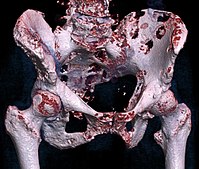
Photo from wikipedia
Background and Purpose To compare two validated spinal instability scores regarding the stabilizing effects and skeletal-related events (SREs) of palliative radiotherapy (RT) in patients with spinal bone metastases (SBM). Materials… Click to show full abstract
Background and Purpose To compare two validated spinal instability scores regarding the stabilizing effects and skeletal-related events (SREs) of palliative radiotherapy (RT) in patients with spinal bone metastases (SBM). Materials and Methods Two hundred eighty-two osteolytic SBM of lung or breast cancer patients were analyzed for stability before and following RT based on the Spinal Instability Neoplastic Score (SINS) or the Taneichi score. Score concordance was quantified by absolute agreement and Cohen’s kappa coefficient. SREs were defined as fractures or local progression after RT. OS was quantified as the time between the start of RT and death from any cause. Results At 3 and 6 months after RT, 35 and 50% of initially unstable SBM were re-stabilized according to SINS in patients still alive. Corresponding Taneichi score-based stabilization proportions were 25 and 46%, respectively. Comparison of both stability scores showed high absolute agreement for all time-points (range 71–78%, kappa range 0.35–0.44). SRE occurred more frequently in initially unstable SBM compared to stable SBM according to SINS (14 vs. 5%), but no such association could be shown for the Taneichi-based instability criterion. Poor general condition of patients was negatively associated with SINS-measured re-stabilization after 6 months, but no predictive factor for re-stabilization could be found for the Taneichi score. Conclusions Despite the relatively high agreement between both stabilization scores, the SINS should be considered the standard for future studies on the stabilization effects of RT in SBM.
Journal Title: Frontiers in Oncology
Year Published: 2021
Link to full text (if available)
Share on Social Media: Sign Up to like & get
recommendations!